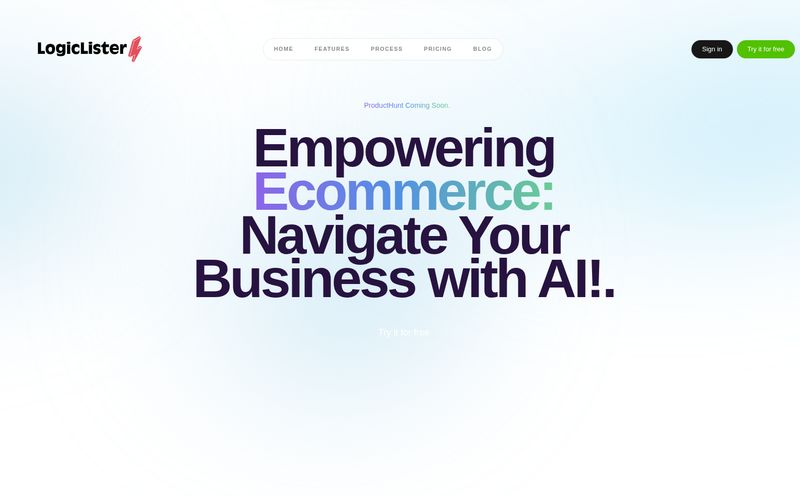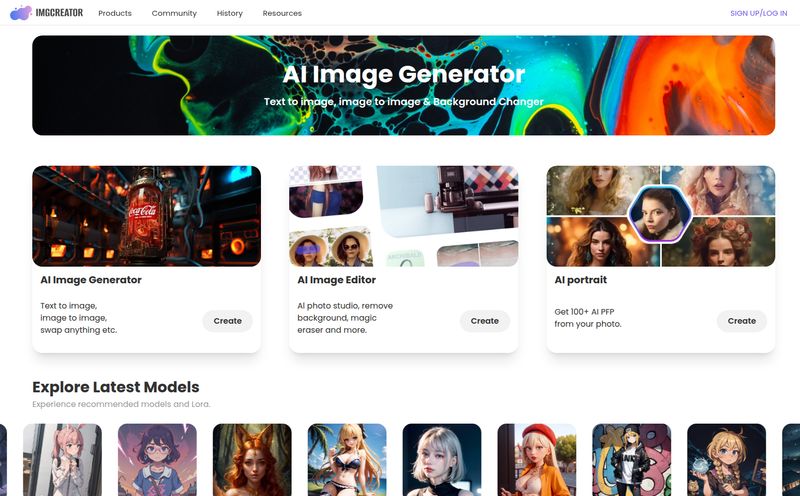It feels like every single day, a new AI tool pops up on my radar. Seriously. It’s a bit like the dot-com boom but for artificial intelligence – a wild, chaotic, and sometimes confusing gold rush. As someone who lives and breathes this stuff, I’m constantly sifting through the noise, looking for the tools that aren’t just another copy-paste job. Most of them are, let's be honest.
But every now and then, something catches my eye. Something a little different. A few days ago, I stumbled upon a platform called Tuval. At first glance, it looked like another AI image generator. Yawn. But then I saw the hook: it doesn't just create pixels, it helps you put those pixels onto physical stuff. And the real kicker? It claims you can generate art from a song.
Okay, now you have my attention. Is this a genuine innovation, or just a clever gimmick to stand out in an impossibly crowded market? I had to find out.
What Exactly is Tuval? More Than Just Pixels
So, what’s the deal with Tuval? Think of it as a hybrid platform. It’s one part AI art generator, like a Midjourney or a DALL-E, and one part print-on-demand (POD) service, like a Printful or a Redbubble. It’s a neat concept, aiming to bridge that gap between creating a cool digital image and actually holding it in your hands.
The website showcases a whole bunch of products you can slap your AI-generated art onto. We're talking the classics like canvas prints and posters, but also more personal items like phone cases, laptop sleeves, notebooks, and even... flip-flops. I'm not sure who's commissioning AI art for their flip-flops, but I respect the hustle.

Visit Tuval
The whole idea is to make the process seamless. You don't have to generate an image in one place, download it, go to another site, upload it, and then place your order. Tuval wants to be your one-stop shop for turning a fleeting thought into a tangible thing. A very appealing proposition, especially for people who aren't super tech-savvy.
The Standout Feature: Making Art from Music
Let’s talk about the most intriguing part of Tuval – the song-to-art generator. This is the feature that made me stop scrolling and actually investigate. The idea of feeding an AI my favorite song and seeing what it spits out is… well, it’s just plain cool.
How does it even work? The site is a little vague on the technical details, but I can only imagine it’s analyzing various components of the track. Does it translate the tempo and rhythm into brushstrokes and movement? Does it pull colors from the mood—the melancholic blues of a ballad or the fiery reds of a rock anthem? I'm picturing what it would do with Queen's Bohemian Rhapsody and the thought alone is a glorious, chaotic masterpiece.
The potential here for personalized gifts is huge. Imagine creating a custom phone case for your partner based on “your song.” Or a canvas print for a friend’s birthday generated from their all-time favorite album. It moves beyond just a pretty picture; it adds a layer of personal meaning that a simple text prompt sometimes can’t capture. It’s a fantastic hook, and honestly, it’s the main reason Tuval stands out from the pack.
From Text Prompts to Tangible Products
Of course, Tuval also has the more standard text-to-image feature that we’ve all come to know. The homepage shows off a range of styles it can supposedly replicate, from painterly aesthetics like Claude Monet and Fauvism to more graphic styles like Pixel Art and Japanese Ukiyo-e. This is crucial; offering stylistic variety means you're not just getting the generic “AI look.”
The workflow seems straightforward: you type your prompt, pick a style, let the AI do its thing, and if you like what you see, you can immediately see how it looks on a poster or a notebook. It streamlines the creative impulse. No more “Oh, that would look cool on a shirt” and then forgetting about it two minutes later. Here, you can act on that impulse right away. It's smart.
The Big Question Marks: Quality and Cost
Okay, let's get down to the nitty-gritty. As promising as Tuval sounds, there are a couple of big, blinking question marks hanging over it. And for me, they’re pretty significant.
How Good is the AI Art, Really?
Let's be real, not all AI art generators are created equal. We’ve been spoiled by the jaw-dropping progress of giants like Midjourney. The bar is incredibly high. Based on the Tuval website, the examples look… okay. They’re interesting, for sure, but there’s not a deep gallery of user creations or high-resolution examples to really judge the engine's power.
The site itself feels a little sparse. Some of the image categories on the homepage were empty when I checked, and I even hit a 404 error page at one point. It gives the impression that the platform might be very new, or still in a beta phase. I need to see more before I can say whether its quality can compete with the top dogs.
The Mystery of the Missing Price Tag
And now for the elephant in the room: the pricing. Or, uh, the lack thereof. I couldn't find a clear pricing page for the printing services anywhere. Is the AI generation free, and you just pay for the product? I assume so. But how much does a canvas print cost? Or a phone case? Does it change based on the complexity of the art?
This lack of transparency is my biggest hang-up. For a casual user, it might be a surprise at checkout. For anyone thinking of using this for, say, a small merch run, it's a non-starter. You can't build a business on guesswork. I hope this is just an early-stage oversight they plan on fixing soon, because in the world of ecommerce and POD, clear pricing is everything.
Who is Tuval Actually For?
After poking around, I have a pretty good idea of who Tuval is for, and who its not for.
This probably isn't the tool for the professional AI artist or the graphic designer who needs granular control over their creations. It’s too much of a black box right now.
Instead, Tuval feels perfectly designed for the everyday person. The creative gift-giver. The person who wants a one-of-a-kind piece of decor for their apartment without needing a degree in art history or prompt engineering. It’s for someone who thinks, “I love this song so much, I wish I could hang it on my wall.” Tuval says, “Okay, you can.” And that’s a powerful, simple promise.
My Final Thoughts on Tuval
So, what's the final verdict? I'm genuinely torn. On one hand, the core concept of Tuval is brilliant. The song-to-art feature is a stroke of genius, and the integrated POD service is incredibly convenient. It has the potential to be a massive hit with a mainstream audience.
On the other hand, the execution feels a bit unfinished. The questions around AI image quality and the complete lack of pricing information are serious hurdles. It feels like a fantastic idea that's maybe 80% of the way there.
Would I use Tuval? For a fun, one-off project or a quirky gift for a friend? Absolutely. The novelty factor is off the charts, and I’m dying to see what it thinks my favorite indie band looks like. Would I recommend it for any serious commercial purpose? Not yet. Not until they pull back the curtain on the costs and give us more proof of what their AI and printers can really do.
Frequently Asked Questions about Tuval
- What is Tuval?
- Tuval is an online platform that combines an AI image generator with a print-on-demand service. Users can create unique images from text prompts or songs and then have them printed on various products like posters, phone cases, and notebooks.
- How does the song-to-art feature work?
- While the exact technology isn't detailed, it likely analyzes musical elements like tempo, genre, mood, and key to generate a visual representation of the song. It's a unique way to create abstract and personalized art.
- What can I print my AI art on?
- Tuval offers a range of products, including canvas prints, posters, phone cases, laptop sleeves, notebooks, and even flip-flops.
- Is Tuval free to use?
- It appears the AI image generation part is free, but you must pay for the physical products you order. However, the platform currently lacks a clear pricing list for its printed items, which is a significant drawback.
- How does Tuval compare to Midjourney or DALL-E?
- Tuval's main differentiator is its integrated printing service and the unique song-to-art feature. While dedicated AI generators like Midjourney may currently offer higher-quality or more controllable image generation, they don't provide a direct path to creating physical products within the same platform.
- Can I sell the products I create with Tuval?
- The platform seems geared towards personal use and gifts. There is no information available about commercial rights or setting up a storefront, unlike other POD services like Printful. You would need to check their terms of service for specifics on commercial use.
A Promising Start
I'll be keeping a close eye on Tuval. There's a spark of something special here. If they can build on their unique features, polish up the rough edges, and just give us a price list, they could easily become a go-to platform for creative and personalized products. For now, it's a fascinating tool with a whole lot of promise.
Reference and Sources
- Tuval Official Website: https://tuval.ai/
- Midjourney AI: https://www.midjourney.com/
- Printful Print-on-Demand: https://www.printful.com/



